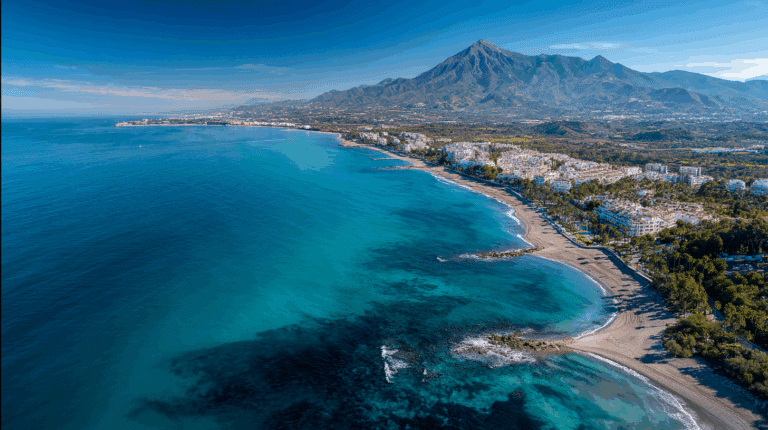Estepona’s Natural Wonders
Nestled on the picturesque Costa del Sol, Estepona is not just a charming coastal town but also a haven for nature enthusiasts. This Mediterranean gem boasts an impressive array of natural wonders that showcase the region’s rich biodiversity. From lush mountain ranges to pristine beaches, Estepona’s diverse ecosystems offer visitors a unique opportunity to explore and appreciate the beauty of nature in southern Spain.
The Rich Biodiversity of Estepona
Estepona’s biodiversity is a testament to the region’s unique geographical location and climate. Situated between the Mediterranean Sea and the mountainous interior, the town benefits from a variety of ecosystems that support an incredible range of plant and animal species.
The Sierra Bermeja, a mountain range that serves as a backdrop to Estepona, is home to one of the largest pine forests in the region. This protected area is known for its rare peridotite rock formation and hosts numerous endemic plant species. Visitors can explore the area through well-maintained hiking trails, offering breathtaking views of the coastline and the opportunity to spot local wildlife.
For those interested in marine biodiversity, Estepona’s aquatic wonderland is a must-visit. The town’s coastline features a variety of ecosystems, from rocky shores to sandy beaches, each supporting its own unique community of marine life. Snorkeling and diving enthusiasts can explore vibrant underwater landscapes teeming with colorful fish, mollusks, and crustaceans.
Flora and Fauna: A Closer Look
Estepona’s biodiversity is particularly evident in its diverse flora. The region boasts over 1,300 plant species, many of which are endemic to the area. The Orchid Garden of Estepona is a testament to this botanical richness, showcasing a stunning collection of orchids from around the world alongside native species.
The fauna of Estepona is equally impressive. Bird watchers will delight in the opportunity to spot various species, including the griffon vulture and the Bonelli’s eagle. The coastal areas provide important habitats for marine birds such as gulls and cormorants. In the waters off Estepona, lucky visitors might even catch a glimpse of dolphins or whales during their migration seasons.
Exploring Estepona’s Natural Wonders
To fully appreciate Estepona’s biodiversity, visitors should explore the various natural areas around the town. Here are some must-visit locations:
Sierra Bermeja Natural Park
This mountainous hidden gem offers hiking trails suitable for all levels of experience. The park is home to the Spanish fir, a rare species found only in southern Spain. The unique reddish soil, due to the presence of peridotite, creates a striking landscape that contrasts beautifully with the green vegetation.
El Saladillo-Matas Verdes Beach
This protected coastal area features sand dunes and native vegetation, providing a habitat for various bird species. It’s an excellent spot for nature walks and bird watching, offering a different perspective on Estepona’s coastal biodiversity.
Estepona’s Coastal Path
The Senda Litoral is a coastal path that stretches along Estepona’s shoreline, allowing visitors to explore different beach ecosystems. From rocky outcrops to sandy coves, each section of the path offers unique insights into the area’s coastal biodiversity.
Conservation Efforts and Sustainable Tourism
Estepona’s commitment to preserving its natural wonders is evident in various conservation initiatives. The town has implemented measures to protect sensitive ecosystems, such as the creation of artificial reefs to promote marine biodiversity and the establishment of protected areas for endangered species.
Visitors are encouraged to practice responsible tourism by following designated trails, respecting wildlife, and participating in local conservation efforts. Many local tour operators offer eco-friendly excursions that provide education about the area’s biodiversity while minimizing environmental impact.
The Future of Estepona’s Biodiversity
As awareness of environmental issues grows, Estepona continues to invest in projects that protect and promote its natural heritage. The town’s commitment to sustainable development ensures that future generations will be able to enjoy the rich biodiversity that makes Estepona a unique destination on the Costa del Sol.
Initiatives such as the expansion of green spaces within the urban area and the promotion of environmental education programs demonstrate Estepona’s dedication to maintaining its status as a haven for biodiversity. The town’s green awakening is setting an example for sustainable coastal development in the Mediterranean region.
Conclusion: A Natural Paradise Worth Exploring
Estepona’s natural wonders offer visitors a unique opportunity to experience the rich biodiversity of the Mediterranean region. From the peaks of Sierra Bermeja to the depths of its coastal waters, the town’s diverse ecosystems provide endless opportunities for exploration and discovery.
Whether you’re an avid nature enthusiast or simply looking to appreciate the beauty of the natural world, Estepona’s biodiversity is sure to leave a lasting impression. By visiting and supporting this coastal gem’s conservation efforts, you can play a part in preserving these natural wonders for future generations to enjoy.
As you plan your visit to Estepona, remember that every step you take through its forests, along its beaches, or under its waters is a journey through millions of years of natural history. The biodiversity of Estepona is not just a local treasure but a vital part of the global ecosystem, making it a destination that truly deserves to be explored, appreciated, and protected.







